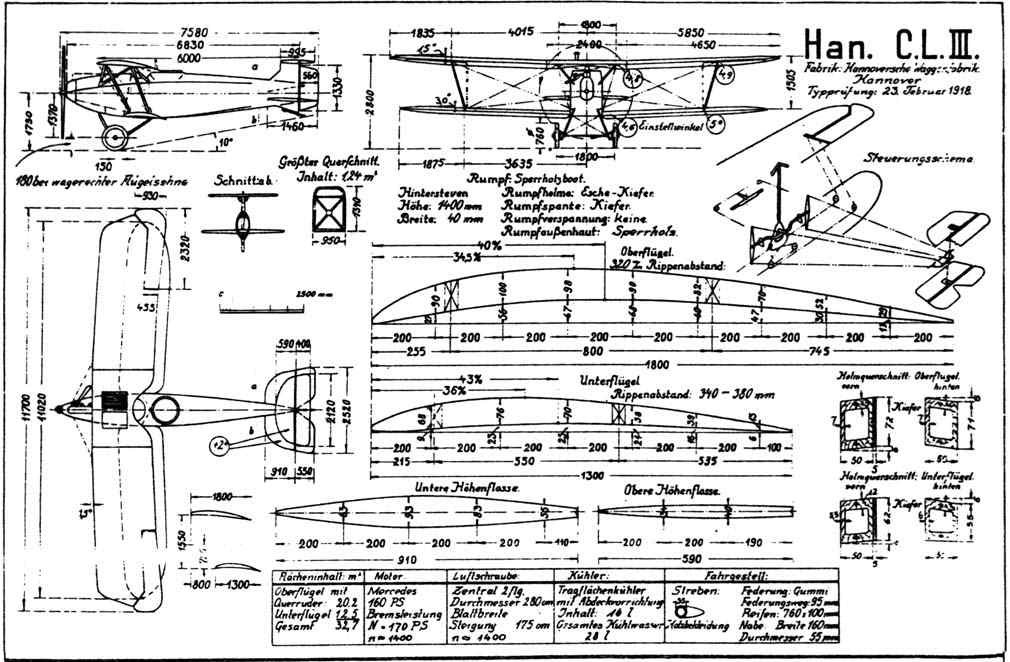Hannover CL.IV on:
[Wikipedia]
[Google]
[Amazon]
The Hannover CL.III was a two-seat, single-bay biplane built by the during the

First World War
World War I or the First World War (28 July 1914 – 11 November 1918), also known as the Great War, was a World war, global conflict between two coalitions: the Allies of World War I, Allies (or Entente) and the Central Powers. Fighting to ...
for the Imperial German Army
The Imperial German Army (1871–1919), officially referred to as the German Army (), was the unified ground and air force of the German Empire. It was established in 1871 with the political unification of Germany under the leadership of Kingdom o ...
's () Imperial German Air Service
Imperial is that which relates to an empire, emperor/empress, or imperialism.
Imperial or The Imperial may also refer to:
Places
United States
* Imperial, California
* Imperial, Missouri
* Imperial, Nebraska
* Imperial, Pennsylvania
* Impe ...
(). It was a multi-role aircraft derived from the CL.II, used to escort reconnaissance aircraft
A reconnaissance aircraft (colloquially, a spy plane) is a military aircraft designed or adapted to perform aerial reconnaissance with roles including collection of imagery intelligence (including using Aerial photography, photography), signals ...
and as a ground-attack
Close air support (CAS) is defined as aerial warfare actions—often air-to-ground actions such as strafes or airstrikes—by military aircraft against hostile targets in close proximity to friendly forces. A form of fire support, CAS requires d ...
machine. It entered service early in 1918.
Development
The CL.III (factory designation Typ 3b) was derived from the CL.II; its airframe was lightened and strengthened to improve performance and it was designed to use the water-cooledMercedes D.III
The Mercedes D.III, or F1466 as it was known internally, was a six-cylinder SOHC valvetrain liquid-cooled inline aircraft engine built by Daimler and used on a wide variety of German aircraft during World War I. The initial versions were introd ...
straight-six
A straight-six engine (also referred to as an inline-six engine; abbreviated I6 or L6) is a piston engine with six cylinders arranged in a straight line along the crankshaft. A straight-six engine has perfect primary and secondary engine balanc ...
engine rather than the Argus As.III engine even though most D.III engines were reserved for fighters. In the event most aircraft used the readily available As.III engines. The Argus-engined variant was designated CL.IIIa. The aircraft had redesigned aileron
An aileron (French for "little wing" or "fin") is a hinged flight control surface usually forming part of the trailing edge of each wing of a fixed-wing aircraft. Ailerons are used in pairs to control the aircraft in roll (or movement aroun ...
s with aerodynamic balances that overhung the wingtips, a modification that provided greater manoeuvrability, especially at the low levels that it was expected to be operating at in its new ground-attack role as the (escort squadrons) were reassigned as (battle squadrons). Like the other Hannover "light-C-class", or "CL" designated aircraft designed by Hermann Dorner, it included an unusual tail structure, with two horizontal stabilizer
A tailplane, also known as a horizontal stabilizer, is a small lifting surface located on the tail ( empennage) behind the main lifting surfaces of a fixed-wing aircraft as well as other non-fixed-wing aircraft such as helicopters and gyroplan ...
s which allowed a wider field of fire
The field of fire or zone of fire (ZF) of a weapon, or group of weapons, is the area around it that can easily and effectively be reached by projectiles from a given position.
Field of fire
The term originally came from the ''field of fire'' in f ...
for the observer
An observer is one who engages in observation or in watching an experiment.
Observer may also refer to:
Fiction
* ''Observer'' (novel), a 2023 science fiction novel by Robert Lanza and Nancy Kress
* ''Observer'' (video game), a cyberpunk horr ...
.
The CL.IIIb was an experimental aircraft that that was used to evaluate the NAG C.III engine. After the war, a single CL.III was developed into the HaWa F.3, a limousine aircraft with seats for two passengers in an enclosed cabin where the gunner's cockpit had been.
Variants
;Hannover CL.III :Powered by a Mercedes D.III engine. ;Hannover CL.IIIa :CL III powered by an Argus As.III engine ;Hannover CL.IIIc :Experimental model of the CL.III, with a two-bay wing. ;HaWa F.3 :A post-war limousine conversion of CL.III aircraft, with a 2-seat limousine cabin behind the pilot's cockpit.Operators
; * ; (Postwar) *Latvian Air Force
Latvian Air Force () is the aviation branch of the Military of Latvia, National Armed Forces. The first air force (AF) units were established in 1919 and re-established in 1992. It has no air combat capability, thus the defense of Latvian air spa ...
– 2 CL.IIIa
;
*Polish Air Force
The Polish Air Force () is the aerial warfare Military branch, branch of the Polish Armed Forces. Until July 2004 it was officially known as ''Wojska Lotnicze i Obrony Powietrznej'' (). In 2014 it consisted of roughly 26,000 military personnel an ...
– 1 CL.IIIa (1919-1920)
;
*Soviet Air Force
The Soviet Air Forces (, VVS SSSR; literally "Military Air Forces of the Union of Soviet Socialist Republics"; initialism VVS, sometimes referred to as the "Red Air Force") were one of the air forces of the Soviet Union. The other was the Sovie ...
Specifications (CL.IIIa)

See also
References
Bibliography
* * * * {{Authority control 1910s German attack aircraft Hannover aircraft Aircraft first flown in 1917 Single-engined tractor aircraft